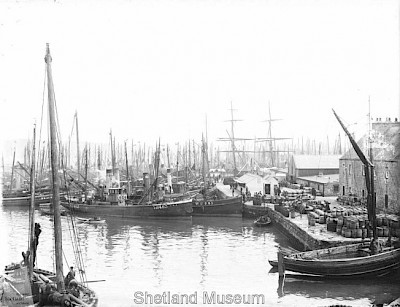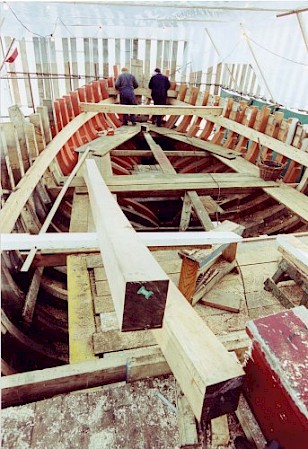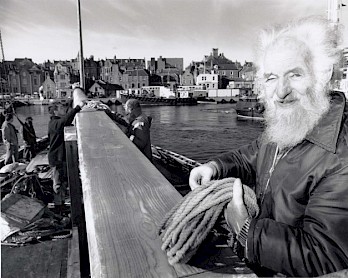Want to get involved in maintaining and operating a traditional wooden sailing vessel? There are a number of different ways you can volunteer to safeguard, care for and sail this unique heritage asset.
Learn more
The Scottish herring fishing experienced its peak in the early years of the 20th century. Every summer hundreds of sailing vessels packed into Lerwick harbour, and other ports around the coastline. Two types of vessel dominated; the Fifies, and the Zulus. These massive timber boats were unique to the Scottish fleet, and were the ultimate development in Scottish herring sail boats.
The Fifies had vertical stern posts, and the Zulus had distinctively angled sterns. The boats measured 75 feet (23 metres) or more in length, and were fitted with steam capstans that enabled them to haul their nets, and handle their enormous masts and sails.
The Fifie Swan LK 243 was launched in May 1900 at Hay and Company’s yard in Lerwick, Shetland. She was regarded as “one of the finest fishing boats afloat in the North of Scotland”. But the Fifies’ days were numbered - steam drifters were already beginning to push sail boats out of business.
The Shetland News, 5th May 1900
An interesting event took place at Freefield docks on Thursday, when a fine new boat was launched for the yard of Messrs Hay & Co. The boat has been built to the order of Messrs Hay & Co., and Mr Thos. Isbister, and is acknowledged by competent judges, both local and Scotch, to be one of the finest fishing boats afloat in the North of Scotland, as regards to model, strength or workmanship.
She is the largest ever built in Lerwick her dimensions being:- Length overall, 67 feet; length of keel, 60.5 feet; beam, 20 feet outside; depth, 9.5 feet from keelson. The timbers are mostly of oak, with larch and pitch pine skin, and in her whole construction practically no expense has been spared in order to secure strength. Fitted with steam capstan and all the latest labour-saving appliances, the boat has every chance of a successful career, and we hope that good luck will always follow her. The launch was carried out most successfully. Miss Ottie Isbister, daughter of the skipper, performed the christening ceremony, the boat being named the "Swan"; and when the fastenings were cut, she left the ways in grand style, and took to the water like a duck, being brought up in the limited space in a most masterly manner. Mr Leask, the builder, is to be congratulated on this his latest addition to the Shetland fishing fleet.
In her early days the Swan was operated from Lerwick and was used for longline fishing for white fish in the spring, and driftnet herring fishing from May to September.
She was taken over by a crew from the island of Whalsay in 1905, and was worked from there for almost half a century. The crew re-rigged her in 1908, to make her more suitable for fishing in inland voes. This ‘smack rig’ is how she is rigged today.
By 1935 the Swan was one of only five herring sail boats left in Shetland. She had an engine fitted, and was given a new lease of life. And when the seine net fishing was introduced in the late 1940s, Swan participated in yet another chapter of Shetland's fishing history. Finally, in the 1950s the grand old lady was retired, and in 1960 towed to Grimsby to be converted to a houseboat. In 1982 she ended up in Hartlepool, where she lay neglected, sinking two or three times due to lack of care.
From the thousands of Fifies that once fished around Shetland, the Swan was now the last. And she was spotted as a classic vessel by boat enthusiast Keith Parkes, despite the fact she lay submerged with only her masts showing.
Keith bought her in 1989 and began to restore her. On completion he planned to sail her back to Lerwick. But the restoration was too time consuming, and he offered her up for sale. His advertisement in ‘The Shetland Times’ newspaper caught the attention of local navigation teacher, Tom Moncrieff.
Tom was a keen yachtsman and expert on all aspects of Shetland's maritime heritage, and also the owner of several classic boats. He wrote a letter to ‘The Shetland Times’ to encourage funding to be sought to buy her, bring her back to Shetland and restore her. He wanted her to be used as a living museum and sail training vessel. He ended the letter saying, "There will never be another Swan". It was true. The Swan Steering Group was formed and negotiations began.

The Swan Steering Group had a survey of the boat undertaken and following a good report it was decided to buy the vessel and bring her back.
In 1991 a crew travelled to Hartlepool, where she was made seaworthy enough to undertake the long journey north to Shetland. Radar, echosounder and a navigational system were all also installed to prepare for the trip – instruments which hadn’t been dreamed of when the Swan was fishing. After four days work she was ready to begin her journey.
The trip wasn’t without its difficulties; the engine had to be kept running as every time it stopped it filled with water due to a cracked liner. And it was later found that the boat’s nails were in much worse condition that previously thought. However, with the crew’s skill and perseverance the Swan made it home.
After a three day journey, enthusiasts gathered to watch her arrival in Shetland and video cameras whirred to capture the moment. She was docked in Lerwick, after an absence of more than 30 years.

The Swan Trust was formed in 1990 and the dream of restoring part of Shetland's maritime tradition was made possible.
The restoration was a painstaking process, which took 6 years to complete. Local craftsmen with specialist knowledge worked to faithfully restore her to her former glory.
On 16th April 1994 the restored and empty hull was returned to the water at Morrison Dock in Lerwick. Over the next two years the internal restoration continued at the small boat harbour, and on 11th May 1996 the Swan made her first tentative sail through Lerwick harbour, almost 96 years exactly since she first took to the water. The Swan spread her wings in the first week of June 1996, sailing from Lerwick to Whalsay, to be reunited with men who had served as crew members when she was a fishing vessel. This first journey was a proud and rewarding moment for all involved.
See images and learn more about the restoration.
In 2021, a BBC Radio Shetland programme celebrated 25 years since the relaunch of the Swan, including interviews with those involved in her return to Shetland, her restoration and new life as a Sail training vessel. Listen to the programme here.
The Swan began her new life as a sail training vessel in 1998. In her first year she did 40 trips, and carried 450 trainees on board. Since then she has become a familiar sight not only in Shetland waters, but also in Orkney, on the West Coast of Scotland, in the fjords of Norway and off the Faroese coast. She has also taken trainees to ports in France, Denmark, Ireland, Sweden, Norway and Holland and around the United Kingdom to take part in the Tall Ships Races.
To generate income to maintain the Swan, and allow people of all ages to experience sailing this historic vessel, the Trust also undertakes public sailing trips.
The Swan has inspired many people; those who have worked and sailed on her, and artists and musicians. She has appeared in modern paintings and photographic works, and has a piece of music composed after her. Hear ‘Swan LK 243’ by Catriona Mackay.
If you’d like to know more about the history or restoration, look out for 'The Swan - Shetland's legacy of sail' by James R. Nicolson, published by the Shetland Times.
Want to get involved in maintaining and operating a traditional wooden sailing vessel? There are a number of different ways you can volunteer to safeguard, care for and sail this unique heritage asset.
Learn morePupils and teachers from Sound Primary School, in Lerwick, recently enjoyed half day sailing trips on Swan - gaining experience in sailing the boat and learning about Shetland's maritime heritage.
Read MoreIconic local boat Swan is set to benefit from a major internal upgrade this winter, following the confirmation of a funding package from local and national sources, and the appointment of a local firm to carry out the work.
Read More